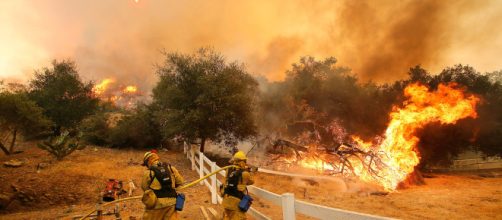Wildfires continue to blaze across the state of California, with an SOS alert still in effect in the southern part of the state. As first responders rush to the aid of those affected, they’re seeking new and more efficient ways to communicate emergency protocol to the Spanish-speaking population.
Roughly 38 percent of Californians are Spanish-speaking, making it second only to New Mexico, which comes in at 47 percent. Since December 4, when the Thomas fire first sparked, its been imperative to let all residents know how to evacuate and which routes to take to safety.
Officials turn to social media to get the word out quickly
One place officials are turning to in order to reach a mass audience quickly is social media. For example, police in Santa Barbara County have used Facebook and Twitter to send out alerts and relay critical information. The only catch? These types of messages are typically written in English. As 45 percent of the population in this particular county alone is Spanish-speaking, this creates a major language barrier and prevents key data from reaching the eyes and ears that need to see it the most.
Case in point? According to the Santa Barbara Independent, immigrant farmworkers in Ventura have been working without face masks for weeks, forced to endure the smoky conditions and poor air quality due to a breakdown in communication between emergency responders and farm owners.
Though N95 masks were collected across the state to aid these laborers, they were delivered far too late, and to little fanfare.
To mitigate issues like these and keep them from occurring again, a report by the L.A. Times reveals that county departments have put plans in place to include both English and Spanish-language updates across all social media platforms. From here on out, everything from public notices to public health information is slated to be delivered in a bilingual format to ensure no one is left out of the loop. There has also been a push for officials to learn more about the Spanish language, as even a few key phrases can mean the difference between someone getting out in time.
A similar communication breakdown in Napa County
While the Thomas fire is bringing these issues to light, this isn’t the first time a wildfire has caused a communication breakdown. A similar issue occurred during the Napa Valley fires back in early October of this year. While Sonoma County burned, officials were left scrambling in an effort to create alerts in both English and Spanish. During the interim, Spanish-speaking radio stations took over and spoke directly to their audience, helping them receive the information faster.
The issue came to a head on October 8, when leaders in Napa County delivered public emergency messages solely in English, creating an immediate uproar within the Latino and Hispanic communities that live there.
It wasn’t until three days later that local aid groups began helping the county translate its communication.
Thus far, many public safety departments have been using apps like Nixle to send notifications to their populace in the event of an emergency. Yet, as was seen in the Napa Valley scenario, there are often opt-in fees that users must pay to receive the messages in a different language, and the opt-in process itself can be tricky to navigate. Moreover, the translations emitted by the app are not vetted for total accuracy, meaning that critical data could be misconstrued, leading to major consequences.
Back in Santa Barbara County, officials are considering creating entirely different social media profiles to communicate in different languages.
Though the change isn’t expected to take place until early next year, it’s a major step in the right direction. Meanwhile, county leaders all over the state are working together to bridge the gap, making sure everyone understands the protocol and decrees announced. If clear communication is key in a crisis, then its never been more important than now.


